
This Poem is a Nest
کتاب های مرتبط
- اطلاعات
- نقد و بررسی
- دیدگاه کاربران
نقد و بررسی

August 1, 2020
A gifted poet demonstrates the remarkable versatility of words through one kind of found poetry. The idea here is that "nested" poems are hidden inside larger poems like nesting dolls. Latham begins with a 37-line poem, describing a robin's nest from its construction in spring through the other three seasons. She finds, nested within the 276 words of this initial poem, 161 new poems built from words in the original. These short poems cover simple themes, such as colors, days, seasons, and animals, as well as more complex ones: emotions and relationships: "What Hope Is: " "a cup / of stars." Only the titles of the nested poems employ words not found in the initial poem--and the titles are charming, often longer than the poems themselves: "What To Do When You Know Something Is Wrong": "mouse / squeaks." The invitations to think metaphorically and to discover poetry that might be right at hand are friendly and clear: "The Power of Imagination: " "turtle tucked in moonlight / makes cathedral / inside" The repetition of words becomes an echo of a familiar melody running throughout the collection as they become the molecules of new poems and become fresh again. Latham's note explaining the process for this collection mentions a few other kinds of found poetry. Wright's art in full-page section-introducing illustrations, along with spot illustration and margin art, gives a warm and lighthearted dimension to the pages. Delightful. (introduction, index) (Poetry. 7-10)
COPYRIGHT(2020) Kirkus Reviews, ALL RIGHTS RESERVED.

October 23, 2020
Gr 3 Up-Latham uses a single poem, which details the seasonal evolution of a bird's nest, as the foundation for 161 smaller "nestling" poems. Latham only utilizes words found in her "Nest" poem to create the other poems, and she keeps the words in the same order as they appear in the original work. The author also achieves the feat of using each of the words from "Nest" at least once. "Nest" is a gorgeous rush of sensory imagery, from "little bits of feather-fluff" to the "wild cathedral of forest" soaring above. The nestling poems center on subjects as diverse as losing a sports game, the color black, a herd of alpaca in the rain, and what to do when you feel hopeless. Each nestling is a warm, accessible, bite-size poem. Some are playful and some are profound. Young writers will be motivated to find their own nestlings and to think deeply about the power of words. Latham offers friendly and encouraging advice on how to create nestling poems and reminds writers that they are both poets and poems themselves. Wright's soft illustrations are gentle, and the ink washes create a lush, dreamy feel. The illustrations of children pictured on each section's title page perhaps skew a bit on the younger side. However, this book can be enjoyed by any age. The children are depicted with light skin and dark skin. VERDICT A beautiful, emotional, and incredibly creative poetry book that inspires reflection, dreaming, and writing. A must for libraries and schools.-Shannon O'Connor, Unami M.S., Chalfont, PA
Copyright 2020 School Library Journal, LLC Used with permission.

March 1, 2021
Grades 3-8 *Starred Review* Latham (Can I Touch Your Hair?, 2018) suggests poems are nests in which poets "gather words, ideas, and dreams, and then . . . set about weaving, arranging, and structuring." A lengthy 37-line opening poem, titled "Nest," solidifies this concept by combining imagery of birds and poets at work throughout the seasons. Latham then uses this anchor poem as a source for 161 very short found poems or "nestlings." These nestlings, in turn, are divided into broad subject areas, from time, colors, and animals to wordplay, places, and final musings. These tiny nestlings, no more than a few lines each, still offer much to ponder: beauty, as in "Violet" ("morning's / glittery web / coated in / woodsmoke); whimsy, captured in "While You Sleep" ("moon / stocks poems / with dreams"); and even wisdom, like that in "A Definition of Maybe" ("hinge between / wild / and safe"). Above all, they encourage metaphorical thinking in young readers, while Wright's grayscale, loosely drawn illustrations enhance these sentiments. Latham ends her work with tips for budding poets to create or find their own nest poems and nestlings, such as using verbs as nouns (or vice versa), joining words to make unique words, and experimenting with the placement of words on the page. This clever poetry exercise will inspire reflection, recreation, or simple enjoyment.
COPYRIGHT(2021) Booklist, ALL RIGHTS RESERVED.

























دیدگاه کاربران